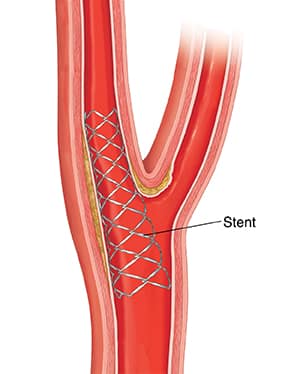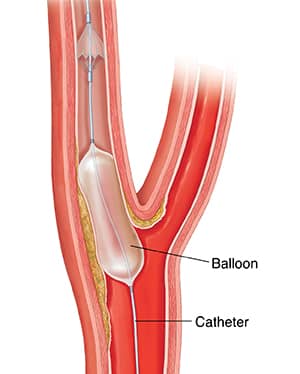Understanding Carotid Angioplasty and Stenting
Angioplasty and stenting are a type of procedure to improve the blood flow in an artery or vein. The carotid arteries are two large arteries on either side of your neck. During the procedure, healthcare providers use a thin tube with a balloon at its tip to open up the artery. A tiny metal mesh tube called a stent is put into the artery. It is left in place to help keep the artery open. It is a minimally invasive procedure. This means it’s done with a small incision.


Understanding the Procedure and Its Risks
Why is Carotid Angioplasty and stenting done?
You have two carotid arteries, one on each side of your neck. These arteries send oxygen-rich blood to your neck, face, and brain. A condition called carotid artery stenosis means that one of these arteries is narrowed. It can’t send as much blood as it should. Carotid angioplasty and stenting can help reopen this artery. Carotid stenosis is often caused by the buildup of plaque on the inside of the artery. This is known as atherosclerosis. Certain things can raise your risk for carotid stenosis. These include:
- Smoking
- High blood pressure
- High cholesterol
- Diabetes
- Obesity
- Aging
If you have mild carotid artery stenosis, your doctor may give you medicines to reduce your risk for stroke. If you have more severe blockage, your doctor is more likely to advise a procedure to open the artery. Your doctor is also more likely to advise a procedure if you have already had a stroke or mini stroke.
Carotid angioplasty and stenting is one option. Another is a surgery called carotid endarterectomy. This surgery removes plaque and any damaged part of the artery. Carotid angioplasty and stenting are less invasive. This means it uses only a small incision. Because of this, you may recover faster. It also avoids the risks of general anesthesia. Talk with your doctor about the risks and benefits of each procedure for you.
How is Carotid Angioplasty and stenting done?
The procedure will likely be done by a doctor trained in vascular medicine and a team of specialized nurses. The doctor will make a small cut (incision) in a blood vessel in your groin. He or she will then put a long, thin wire into this cut. The doctor will then insert a thin, flexible tube (catheter) over the wire. It has a tiny, deflated balloon on the end. The catheter will be threaded up into the carotid artery in your neck. The balloon will be inflated inside the narrow part of the carotid artery. This will stretch the area open. A mesh tube called a stent may be left in place in the area. This will help keep the area open.
Risks of Carotid Angioplasty and stenting
All procedures have risks. The risks of this procedure include:
- Infection
- Heavy bleeding
- Artery injury
- Allergic reaction to contrast material
- Kidney damage
- Stroke
- Heart attack
- Sudden vessel closure
- Low blood pressure
- Heart arrhythmias
- Return of the blockage
Your risks may vary based on your overall health, the severity of your condition, and other factors. You may have an increased risk for complications if you:
- Have symptoms from your carotid stenosis
- Have had a stroke or mini stroke
- Have other health conditions such as diabetes
Ask your doctor about which risks apply most to you.
© 2000-2025 The StayWell Company, LLC. 800 Township Line Road, Yardley, PA 19067. All rights reserved. This information is not intended as a substitute for professional medical care. Always follow your healthcare professional’s instructions.
Our Services
- Teleneurology >
- Brain Vessel Imaging >
- Clinical and Interventional
- Neurology
- Mechanical Thrombectomy >
- Aneurysm Coiling >
- Carotid Stenting >
Related Articles
By the Numbers
15,145 +
2018 STROKE ALERTS
119 +
2018 TPA CASES
815 +
2018 CONFIRMED STROKES
125 +
2018 INTERVENTIONAL CASES